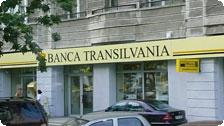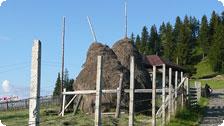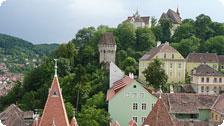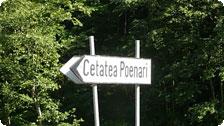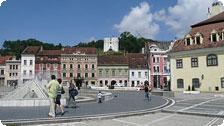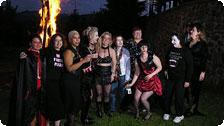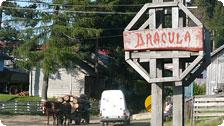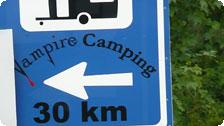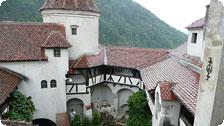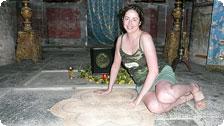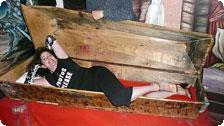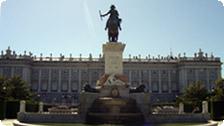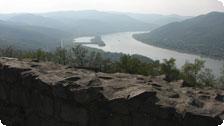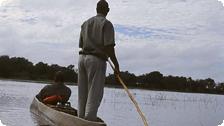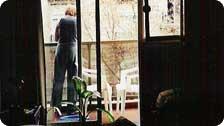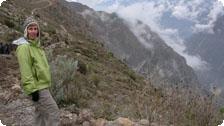Culture: Romania: Transylvanian Dreams and Dracula Nightmares
by Stephanie Block
In a word: Radu. Our guide, with his encyclopedic knowledge, passion for history, and unwavering energy, made the difference between a great trip and a once-in-a-lifetime one.
Amidst the lackluster cuisine (who knew there was so much schnitzel in Transylvania?), shabby 3-star hotels (except Hotel Dracula of course!!) and hotter-than-three-hells weather in Bucharest, Radu and his unflappable expertise, like Dr. Frankenstein in his secret lab, brought the past to life.
The trip was fright-filled even before I touched down in Romania. At 35,000 feet somewhere over the Atlantic, I took advantage of my hulking, muscle-bound aisle seatmate’s absence to stretch and powder the old nose. I pushed open the accordion toilet door and found Mr. 32D sitting there, tremendous pants around his ankles, hands cupping his genitalia. We stared at each other in horror. I managed to pull the very unlocked door closed. To call the next five hours awkward would be a gaping understatement.
Mine was not the only shocking trans-oceanic passage. Poor Jeanne and Leonard Pickel, owners of Haunted Attraction Magazine, were schedule to arrive in the Sahara, I mean Bucharest, late that first night. As if on cue, a terrible storm suddenly thundered through the city, baptizing our Dracula Tour in frightening ambiance.
On that dark and stormy night, their pilot tried valiantly to land at Otopeni Airport. The plane shook violently right and left, port and starboard, passengers screaming, praying, vomiting. He wisely gave up, banked right and headed for Costanza on the Black Sea (yes like that guy on Seinfeld), a fine resort town and NATO military base to wait out the storm. They finally landed in Bucharest at 2 a.m. Ouch.
Radu thought this was hilarious and teased them the whole time: “Our tour does not include the Black Sea! Did you make the pictures?”
Day One found us lumbering through muddy dirt roads on our big blue bus (with its gorgeous driver) towards Snagov, the burial place of Dracula. Now I had done some research on Dracula tours and this was the only one that included Snagov on its itinerary. I was incredulous. Why on earth wouldn’t all tour companies come here? I soon found out why.
Picture, if you will, the algae-est little lake you’ve ever seen. Put an island in the middle of it with an ancient Orthodox Christian monastery complete with a lonely caretaking monk and not one congregant. Add a few goats and you’ve got Snagov. How to cross this lake where not falling in is the greatest consideration? Walk out on a rickety old dock, hoist yourself down into a tiny rowboat, and hold on tight while an old man rows you out…that’s how!
How on earth the Halloween Dracula Tour with its 80 or so people (we were 18 in July), two buses and wildest tourists make it across every year was a mystery to us. It must have taken all day!
I was in the first group on the rowboat, clutching the sides, bemoaning my muddy sandals, avoiding the sludge off the splashing oars. And then we were ashore. We were the only tourists for miles, and down the path came the monk to greet us, formidable in his black cloak and beard.
And just like that, I was hooked on Romania.
Who Is Dracula?
Now you’re probably wondering how Dracula could even have a grave since he’s still sort of alive, and whether he was in his coffin, and were we able to drive a stake through his heart? (Of course given my constant attraction to the wrong men, you’re probably really wondering if I didn’t go quite the other way.)
The Dracula legend is actually based on 15th century diabolical Vlad III, prince of Wallachia. Vlad Dracula’s father, pronounced Dra-koo-lia, or Dra-koola but never Dra-kyu-la, was a member of the Order of the Dragon, a secret society dedicated to defending the Christian world against the Ottoman Turks. So Dracula means son of the Order of the Dragon. A really rather nice title at the time, although Drac also means devil.
Vlad was fierce and merciless in his quest for order, loved by his people and feared by invaders. Under his rule, a golden drinking cup was set out at a fresh spring, and there it stayed as no one dared to steal it. Against the mighty Ottoman Empire encroaching on Europe, Vlad used fearsome methods. He became known as Vlad Tepes, meaning Vlad the Impaler.
Let’s get gory. Being impaled means having a sharp wooden spike lubed up and pushed through your body via the anus, exiting through the mouth or anywhere you like. A military historian on our tour said that Vlad was not the first to use this means of punishment, but he was the first to perfect it by rounding off the tip of the stake to make death come slower. Yeesh.
There are fabulous stories regarding Vlad and the Sultan, too numerous (sadly) to go into here, but highlights include the time when some sultanic envoys came to see Vlad and refused to take off their turbans, so Vlad nailed them to their heads. Or the time when a nobleman came to dinner and complained about the smell of all those impaled, rotting corpses around the table. So Vlad politely impaled him on a higher stake above the stench.
And especially the time when the Sultan finally drew his forces close enough to attack, but as he rounded the bend he found an entire field of human impalement, 20,000 strong, with even children clinging to their mothers’ breasts. He proclaimed that he could not conquer the country of a man who could do such things (probably because his army was scared out of its wits).
Now before you start to feel sorry for the Sultan, remember that he like started it by kidnapping young Vlad and his brother Radu the Handsome (no admitted relation to our guide) and turning brother against brother when Radu chose to stay (some even say that Radu and the Sultan were sitting in a tree, k-i-s-s-i-n-g…).
Day Two and Onwards
Meanwhile, back on our tour, we piled into the bus and left Snagov for Bran Castle, nicknamed Dracula Castle, even though our hero only spent about six months here, imprisoned in a narrow hallway. The edifying edifice is for sale, by the way, for about $140 million, so you might just be able to beat Disney to it! Rumors, just rumors…
The real story here is not Dracula but a true Diva by the name of Queen Marie. She was queen of Romania living in Bran Castle in 1917 when German forces threatened to overwhelm. Radu told us that her husband turned tail and ran for the hills, but Marie stayed back and came up with a wickedly successful plan to beat them into a retreat.
Hasta la vista, Germans! A devoted Romanian patriot, patroness of the arts and especially composers (wink, wink), and profligate lover, the passionate queen’s heart is buried at Bran. And I don’t mean figuratively.
Another devilish sight we beheld was famed Borgo Pass (actually called Bargo Pass), the very spot where Bram Stoker writes that Jonathan Harker travels through to meet Count Dracula:
“Then the mountains seemed to come nearer to us on each side and to frown down upon us. We were entering on the Borgo Pass.”
Now Irishman Bram Stoker never visited Transylvania himself but relied on copious records and histories full of local lore and geography. He knew that Borgo Pass is actually no where near Bran Castle, but he chose wisely of his names. In fact, Vlad Tepes was prince of Wallachia, not Transylvania, but we all know which sounds more romantically sinister.
Speaking of taking writers’ liberties, I am going to abandon all chronological order (mortals are so tiresome in their slavery to time) and tell you about the surprising towns of Transylvania we visited. This land beyond the forest (literally what Transylvania means), hemmed in by craggy Carpathian peaks, is stunningly replete with perfectly preserved medieval, Renaissance and Gothic towns. Those UNESCO World Heritage folks went wild here.
Spectacular Sighisoara, beautiful Brasov, five-star Sibiu…our dusty coach left one gorgeous town center for another, all the while passing horse carts loaded with lumber, stork families nesting atop telephone polls, pitchforked villagers (what, no burning torches?) making hay while the sun shone, and among the domes of hay stacks proudly stood Orthodox churches with their double crossed crosses and feminine onion towers of shining silver.
Charming Sibiu celebrated its title of European Capital of Culture for 2007. Also called Hermannstadt, the old Saxons here believe that they are descended from the children lured away by the Pied Piper of Hamelin! As always, legend mixes with history here.
This point was not lost on Bram Stoker: “I read that every known superstition in the world is gathered into the horseshoe of the Carpathians, as if it were the centre of some sort of imaginative whirlpool…”
Here you will find Frankenstein buried near Dracula’s son. Apparently, Mary Shelley’s monster was modeled on the von Frankenstein family, a noble clan who married each other until they begat an Elephant-Man-like stricken child. This genetic victim enjoys an immortal place in a deathly rogue’s gallery in Sibiu. The Gothics lived with death and had a sense of humor about it. One skull and crossbones grave promises, “Today me; tomorrow you.”
Morbidly Missing My Tour
Me? I’m experiencing (sadly) more Radu withdrawal than blood withdrawal. I find myself sitting in my preposterously young house at only 100 years old, wanting to summon my guide at a moment’s notice.
Radu, why is the sky blue?
Radu, could I have gotten smallpox from that deathly ill, pock-marked family who sat behind me on the 40-minute flight from Sarajevo to Belgrade?
Radu, how do you tie a sheepshank knot?
I bemoan my black and white, elbow-length skull gloves, the only accoutrement that fit in my suitcase for our tour’s costume party at the Hotel Castel Dracula. Everyone else went all out, Danni with her leather corset and especially Jeff Londos, owner of Monster-Tronics, whose animatronic creature poking out from his sternum put us all to shame and had the waitresses backing away from clearing his plate.
I also bemoan Danni’s husband Jordan, a different skull shirt for every day, who listened to my plum brandied tales of having a crush on our gorgeous busdriver. He caught the man’s attention, pointed at me and gave a little wink. Constantine held up his wedding-ringed left hand. Jordan shook his head and told me, “You should really look to see if they have a ring first.”
I turned a red three shades darker than the hotel’s spooky carpets. Luckily it was time to tour the castle’s dungeon. As we took turns climbing into the coffin and posing for pictures, I wanted to close the lid and hide until the trip was over! I knew from then on I’d have to hitch rides on horsecarts…
But I applaud the fact that I made it up all 1500 steps to see the frightful ruins of Poienari Castle, the fortress that Dracula rebuilt and inhabited, from whose tower his second wife jumped when she thought the citadel was hopelessly surrounded on all sides by Turks. Her (not-so?) loving husband was already halfway through the secret escape tunnel. The climb is daunting; the view sublime; the tourists few and far between.
Some on our tour were paranormal investigators, and others prolific writers like Charles A. Mills. Some hoped for more realism in their haunted attractions and others bonded with their very nice parents who agreed to the trip. Thanks to her mom, it was Corinne’s first taste of life outside the U.S. What a ghoul-tastic choice! Some came with friends, others with lovers, and two friends actually met on the tour website’s message board and decided to split the costs. (Curses upon you, single supplement!)
We were all there, in some way or another, to ponder death and brood over mortality in every graveyard, tomb and crumbling edifice. None more so than cancer survivor Dave on the brink of his 60th birthday, animatronic himself with a pacemaker, an unhappy result of a life-saving drug therapy he underwent. When we saw him stride up to the top of Poienari, we realized that the Dracula legend inspires a little immortality in us all.
I think Stoker said it best:
“In the summer of this year we made a journey to Transylvania, and went over the old ground which was, and is… so full of vivid and terrible memories… We could hardly ask any one, even did we wish to, to accept these as proofs of so wild a story. Van Helsing summed it all up as he said… ‘We want no proofs. We ask none to believe us!’”
* * * *
Do you dare go on a Dracula Tour yourself? Open the virtual creaky door at www.dractour.com. Trips leave every Halloween and summer. Don’t you vant to join them? It may be the last trip you ever take! Ha-ha-ha-ha (cue thunder clap…).
Discover more from Tango Diva
Subscribe to get the latest posts sent to your email.
